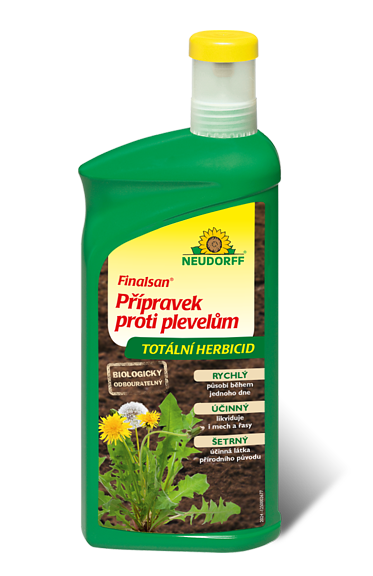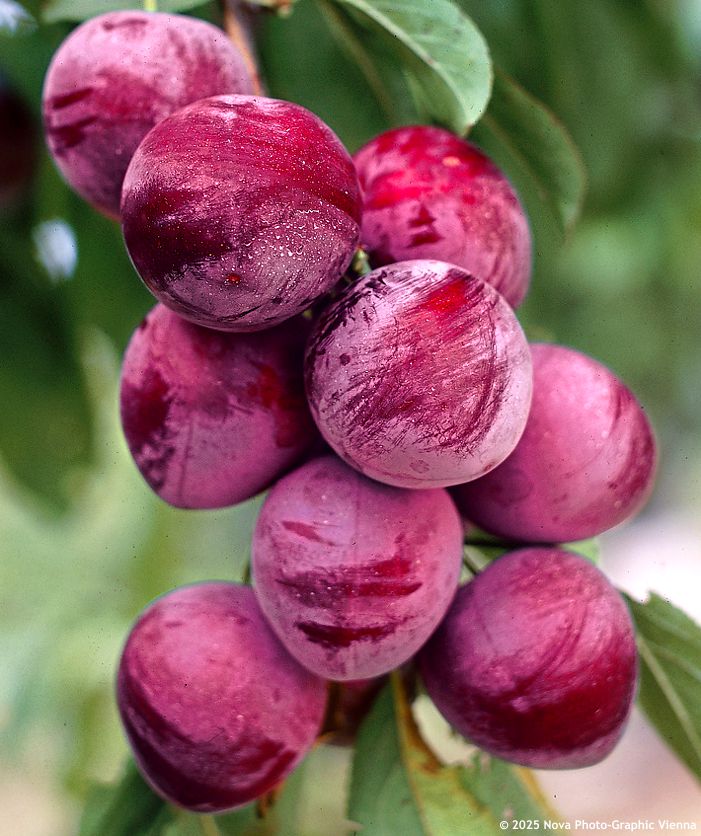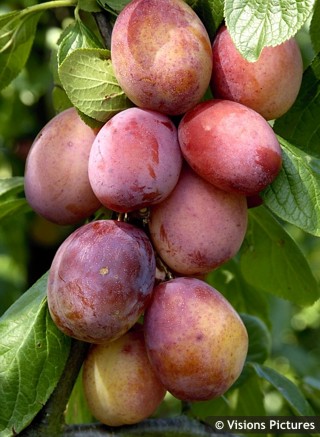Prunus salicina 'SANGUE DI DRAGO' Japanese plum
Prunus
Japanese Plum (Prunus salicina) is a fruit species that only arrived in Europe during the 20th century, although its origins trace deep into Asian history. It comes from the region between China and Korea, where it was cultivated more than two thousand years ago. It spread to Japan as a cultivated crop, and it was there that it received its name – “salicina” refers to its willow-like leaves. Botanically, it belongs to the genus Prunus, just like European plums, apricots, or cherries, but it differs from its European relatives not only in appearance but also in taste and fruit texture. It is characterized by rapid growth, early flowering, and round, often very juicy fruits that ripen in the first half of summer.
Its breeding was notably influenced by American botanist Luther Burbank (1849–1926), who, at the turn of the 19th and 20th centuries, developed dozens of hybrid cultivars by crossing it with other Prunus species. His goal was to improve flavour, fruit size, disease resistance, and shelf life, laying the foundation for modern commercial plum cultivation worldwide. In Japan, this plum known as ume holds deep symbolic meaning. Its blossoms, which appear in the winter months, represent strength, renewal, and new beginnings. Traditionally, it has been a motif in poetry, visual arts, and seasonal celebrations – before cherry blossoms became iconic, plum trees were the centrepiece of spring hanami. The fruits of the original species were small and intensely sour, ideal for making umeboshi (pickled plums) or umeshu (plum wine), while modern cultivars are larger, juicy, and pleasantly sweet, intended primarily for fresh consumption. The plum thus bridges the worlds of plant breeding, aesthetics, philosophy, and everyday life in Japanese society.
Sangue di Drago (Dragon’s blood) is a Japanese plum variety that truly lives up to its name. The fruit of this Japanese plum has flesh so vividly red it evokes the mythical creature’s lifeblood. The plums are large, round, with a deep red skin covered in a fine, natural bloom. The flesh is firm, moderately juicy, sweet-tart, and carries a pronounced aromatic note reminiscent of wild berries. The juice is intensely crimson, making this variety especially valuable in the kitchen – not only for jams and preserves, but also for fruit sauces, sorbets, homemade lemonades, or as a natural colouring agent in baked goods and desserts. It typically ripens in August, though in cooler regions the harvest may extend into late summer. The fruits are not prone to cracking.
Yields are regular, and for home gardeners, the tree does not require a pollinator thanks to its partial self-fertility. However, when planted near compatible varieties such as ‘Golden Japan’, ‘Morettini 355’, or ‘Santa Rosa’, it offers significantly higher commercial yields. The tree grows vigorously, forming a wide, spreading crown and reaching heights of up to 6–9 meters. Its leaves are broadly ovate to lance-shaped, dark green, and its simple, star-shaped white flowers appear in April. With its striking appearance, the tree attracts not only gardeners but also butterflies, bees, and birds. Due to its size and extensive root system, it is best suited to larger gardens or orchards where it has room to thrive. Container cultivation is not recommended—this tree requires deep soil and a stable microclimate. In Europe, Japanese plums are most commonly grafted onto myrobalan, which excels in vigorous growth and excellent adaptability to various soil types. For smaller trees, St. Julien A is used due to its more moderate vigour, while Marianna 2624 offers good disease resistance, and Citation provides compact growth and early fruiting—though it is less common in Europe and mainly used for rarities like pluots and similar hybrids.
Japanese plum is not demanding to grow. It thrives best in a sunny location protected from strong winds, especially in the first years after planting. The soil should be loamy to sandy-loamy and well-drained; in heavier soils, drainage or elevation of the planting site is necessary. The tree requires regular watering, especially during fruit development, but does not tolerate persistently waterlogged soil. Fertilization is best done in spring and early summer – ideally with organic fertilizer high in potassium. Its hardiness ranges between -27 to -29 °C. In containers of at least 50 litres, it bears reliably if regularly watered and fertilized. The tree is not prone to diseases, but in rainy years it may be sensitive to monilial fruit rot – prevention includes an airy crown and timely harvesting.
Last update 20-10-2025

































.jpg)




